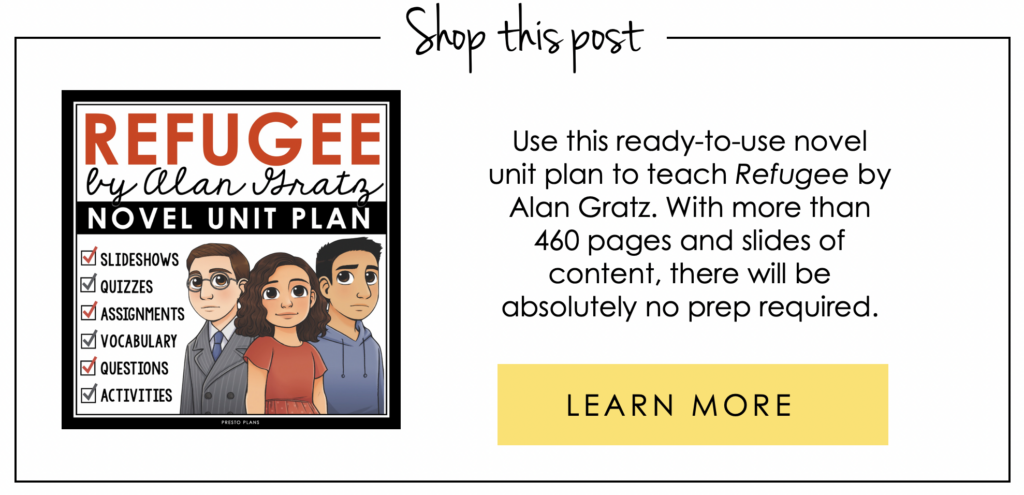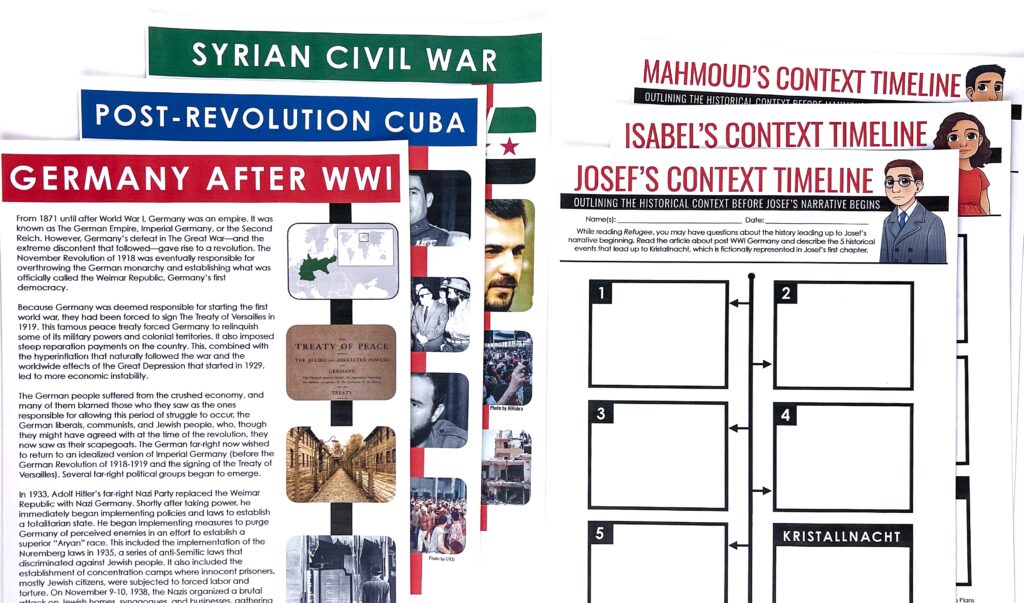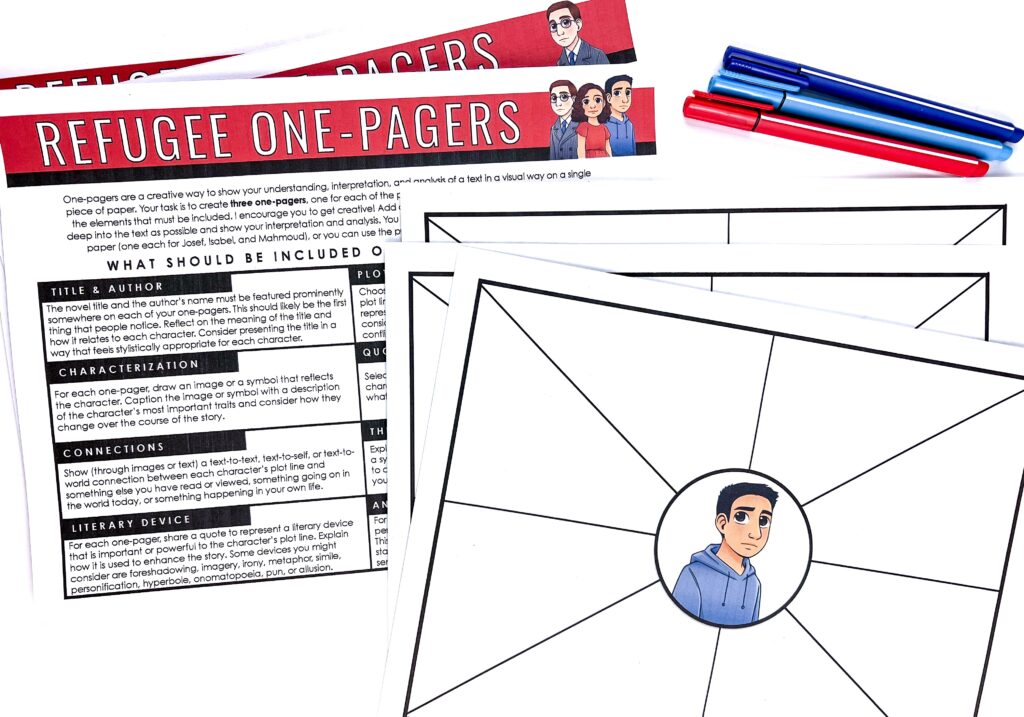PRESTO PLANS
Sent straight to your inbox
CLICK HERE TO ACCESS
Sign up to receive 10 ready-to-use ELA resources your students will love!
10 FREE ELA RESOURCES

Teaching Refugee by Alan Gratz: 12 Creative Activities
One of the reasons I am so drawn to middle school ELA is the power of fiction as a tool for helping students develop a greater sense of empathy. I believe that there’s no better text to use for teaching themes of empathy, kindness, and the human experience than Refugee by Alan Gratz.
Fiction gives the reader a chance to see through a character’s eyes. I know that personally, as a reader, I often can gain greater understanding about issues such as personal struggles, sacrifice, or even the impact of global events, like war, when I explore them through the eyes of an individual character.
This is why I get so excited about teaching Refugee by Alan Gratz. Packed with adventure, insights into the historical and modern experiences of refugees, and opportunities to build empathy and global citizenship, this moving book is a great choice for middle school readers.
Here are some of my best tips and activities to make the most out of teaching Refugee by Alan Gratz.
Pre-Reading Activities
I like to begin teaching Refugee by Alan Gratz by helping students build on their existing awareness of the themes and historical context of the novel.
First, focus the class with a quick game of “Do You Agree?” This is a no-prep activity – simply begin with all students standing up, and ask them to remain standing if they agree with statements like these:
- Fiction and storytelling has the power to change people’s minds and hearts.
- Sometimes we need to make sacrifices today for a better tomorrow.
- There is strength in kindness.
Next, I might have students examine and reflect on the book’s cover, explore biographical information about the author, and then get into the overall structure of the novel.
It’s important for students to understand that the novel follows the story of three young refugees living at different times: Josef is a young Jewish boy living during 1930s Nazi Germany. Isabel is a Cuban girl during the 1994 rafter crisis. Finally, Mahmoud is a Syrian boy living through the Syrian Civil War in 2015. Although they are fictional characters, their tales are based on true stories.
Chapters 1-6
While students engage with the first six chapters of the novel, I find it helpful to continue building background information. In my opinion, web quests are an ideal way to do this! Within a structured framework (where I provide research sources and guiding questions), I like to get students explore articles and resources related to refugees and their experiences. During this web quest, students learn more about important terms. These include what makes someone a refugee, what a refugee’s experience leaving their home is like, and how they can help.
Another way to build background information is to have students learn more about the history of Germany, Syria and Cuba—the events that transpired (and led to) these 3 individual stories. You might use an historical timeline assignment, where students learn about these events in groups or individually.
First they read nonfiction articles about the important historical moments leading up to Kristallnacht in Josef’s narrative, the Malenconazo protest in Cuba in Isabel’s narrative, and the Aleppo bombings in Mahmoud’s narrative. Then, they summarize the article into the four major events that led to these moments in history. You might even like to turn the end result into an engaging bulletin board display!
Lastly, when teaching Refugee by Alan Gratz, I like to make sure students have a graphic organizer, where they can jot down important themes or recurring interconnected ideas from the novel. Because the novel is packed with so many important—and often interconnected—motifs, this helps students keep track of them. They can later use this as a reference when writing about the novel in a thematic final essay.
Chapters 7-12
The action in Refugee really intensifies in this second section when Isabel and her family leave Cuba on a makeshift boat. As this part of the book is set in 1994 (long before your students were born!), the class may need a bit of additional information about the Cuban Raft Exodus. Here, students can scan QR codes to explore more, including articles and captioned photographs.
Once they have had the opportunity to explore these articles, students then step into the role of a journalist covering the story at the time. Thinking creatively, drawing inspiration from the novel, students must consider how Isabel (and other characters accompanying her on the journey) would have responded to reporters’ questions while boarding their raft.
Chapters 13-18
By the end of the third section of the book, middle schoolers should have an increasingly strong understanding of how the characters’ stories are connected. At this point in teaching Refugee by Alan Gratz, I like to pause and introduce a creative writing task.
To begin, ask students to imagine that one of the three main characters (Josef, Isabel, or Mahmoud) has a magic bottle that, when dropped in water, can travel through time and space. Eventually, the note inside will be delivered to another character from the novel.
Using text evidence, students take on the perspective of any of the three characters, and write a letter to one of the other characters. The goal in writing is to share the character’s life experiences, the challenges they have faced, how they feel, and their hopes for the future. In this task, students also have the opportunity to reply – in character – to either their own letter or a classmate’s note. For the reply, the content will largely focus on the connections between the two stories.
In my experience, assessments like this are very useful for checking in with my students. I can really tell who “gets it” and who might need a little bit more support with tricky concepts like theme.
Chapters 19-27
At first glance, a poetry assignment in the middle of teaching Refugee by Alan Gratz might seem out of place. But trust me! Students always rise to the occasion and often express very creative insights through poetry.
To begin, I teach a brief lesson on blackout poetry. I explain that a blackout poem is a type of found poetry that is produced by intentionally redacting (blacking out) the words in a text, often with a black marker. The words that remain form the new blackout poem.
Once students understand the idea, it’s time to create their own blackout poetry, using Refugee as the source text. I like to do this in a six-step process:
- Choose the source text and make a copy of the page (or pages!) the student wishes to use for their blackout poem.
- Students carefully read and analyze their source material.
- Working with light pencil, begin the process of leaving words unredacted (in other words, not blacked out!).
- Students should finalize their creative choices by reading over the poem carefully, making sure that it builds on a common theme and, more practically, can be read from left to right.
- Using a black marker (I’m partial to fine-tip Sharpies), students should “square off” their final words. One final double check might be in order here – there’s no going back!
- Students can now “black out” the rest of the page. They might like to incorporate some creative designs (i.e. shapes) into this process to emphasize themes.
Tip: Blackout poems are a fantastic way to refresh your Refugee bulletin board at this mid-way point of the novel!
Chapters 28-36
As students continue reading the book, they may be compelled to learn more about the experiences refugees may have in their own community. Teaching Refugee by Alan Gratz provides so many opportunities to make text-to-world connections, including exploring local current events.
Chapters 28 to 36 focus on the enduring theme of the impact of kindness on those who have fled their homes in search of a better future. With this in mind, there is an opportunity to help students see how they have the power to have a positive impact on refugees who are new to their country or community.
Writing a letter of welcome to a newly-arrived refugee is a real-world task students can really get into. Even better, you may be able to seek out a place to deliver these letters within your own community.
A handout with detailed instructions for writing the letter is included in my comprehensive resource for teaching Refugee by Alan Gratz. This resource also includes a pre-writing graphic organizer and a letter template.
Chapters 37-45
As the book builds to its climax across the three inter-woven narratives, students often appreciate learning about human rights. While teaching this section of Refugee by Alan Gratz, I like to lead two activities:
Refugee Human Rights Activity:
In this task, I like to introduce students to the Universal Declaration of Human Rights. From here, I have them apply what they learn to the novel. First, students learn about the 30 universal human rights. Next, they can apply their learning as they analyze the human rights violations in Refugee.
For this assignment, they must consider each of the three protagonists’ experiences. Working alone or in groups of three (taking on the perspective of one character each), they compose a paragraph that describes the violations each character experienced in the novel, using text evidence.
“The Perils of Indifference” by Elie Wiesel Activity:
The Perils of Indifference is a well-known speech by Holocaust survivor and Nobel Prize winner Elie Wiesel. This speech – which is widely available in audio, video, and print forms – is an ideal springboard to explore the ideas of indifference.
To make this task meaningful for middle schoolers, I like to provide task cards featuring quotes from the speech. Once the class has viewed the speech together, small groups of students can use the task cards to guide discussions related to the consequences of an indifferent attitude, particularly as it relates to refugees.
If you like, this empathy-building task can be extended into a writing activity. For this task, students can reflect on a quote that resonated particularly strongly with them, and support their thoughts with evidence from either the speech or the novel.
Chapters 46-53
To conclude your novel study, your middle school readers will enjoy reviewing the plot of the novel with an engaging game! In the Refugee Plot Matching Mystery Quote Game, students sort out plot cards for each of the three narratives. When the game is completed correctly, a powerful quote related to the theme of the novel will appear!
I also love to finish teaching Refugee by Alan Gratz with meaningful final assignments. Here are three of my favourites:
“Refugees” by Brian Bilson Poetry Connection Activity:
During this poetry response activity, students can make connections between Brian Bilston’s poem “Refugees” and Alan Gratz’s novel Refugee. Bilston’s poem, upon first read, presents a negative perspective of refugees. However, this all-too-common perspective gets flipped on its head when the reader is instructed to read the poem in reverse. Once students have had the opportunity to explore the poem, I get them to complete a response assignment, which contains guiding questions to support students as they compare the two texts.
Refugee Final One Pager Creative Project:
One-pagers are a creative way for students to demonstrate their understanding, interpretation, and analysis of a text on a single piece of paper. I find that visual thinkers really love this type of task!
For this final novel project, students will create three one-pagers, one for each of the plot lines in Refugee. I provide detailed instructions for what needs to be included on the one-pager, pre-writing graphic organizers for planning, and one-pager templates for each of the characters. The final presentation is up to each student!
Refugee Final Essay Topics:
Another option is to finish off your Refugee unit plan by having students write a final essay. Ready-to-use topics are a low-prep way to introduce this writing task. (Note: My provided topics align with the thematic graphic organizer that students completed throughout the unit.)
There you go! I hope this post inspires you to try out teaching Refugee by Alan Gratz in your classroom this year! The resources mentioned in this post (as well as many more!) are available in the Refugee Novel Study Reading Unit bundle.

Looking for more complete novel study units? Check out these blog posts about other popular middle school novels!
8 Creative Activities for Teaching The Giver by Lois Lowry
10 Creative Activities for Teaching Percy Jackson: The Lightning Thief by Rick Riordan
Search the blog for what you are teaching
GIVEAWAYS
sent straight to your inbox!










share this post